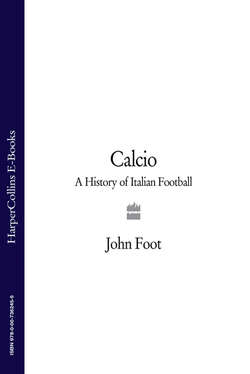Читать книгу Calcio: A History of Italian Football - John Foot - Страница 70
The King. Maradona and Napoli. 1984–1991
ОглавлениеIn the still desperately poor Spanish Quarters of Naples, groups of small boys drive motorbikes at high speeds through the tiny streets. Here, you can still see damage from the 1980 earthquake and the population density is amongst the highest in Western Europe. On one wall, towards the top of the quartieri, there is a huge mural. It depicts a man with black curly hair and a blue Napoli shirt. The mural is so large that an (illegal) window only takes up part of the face. It is peppered with bullet holes – local criminals used it for target practice, it appears.13 The man is instantly recognizable, and not just to locals: Diego Armando Maradona – the King of Naples. Maradona played for Napoli between 1984 and 1991. In that time the team, which had won only two Italian Cups in its entire history, triumphed twice in the Italian championship (and finished second twice), as well as winning an Italian Cup, a UEFA Cup and an Italian supercup. In the same period, Maradona won the World Cup with Argentina and pushed his team to a second successive final, beating Italy, in 1990, in Naples of all places, on penalties. Since Maradona’s departure, Napoli have returned to their previous ways, winning nothing. In 2005 they were to be found way down in Serie C after having gone bankrupt. For a team with a fan-base which rivals that of the big three Serie A clubs, this was an astonishing decline.
The story of Maradona’s time at Napoli, when he was probably the best player in the best league in the world (a league with Platini and Mattheus and Van Basten and Zico), was one of poetry, histrionics, scandal, suspicion and doping. It was also the story of the greatest series of celebrations ever seen in domestic football history.
Between 70,000 and 90,000 people turned up, paying 1,000 lire each, to watch Maradona kick a ball around in the San Paolo stadium after he had been signed in June 1984, eclipsing the 20,000 who saw Omar Sivori train twenty years earlier. Tortuous negotiations with Barcelona had ended with the 23-year-old arriving at the end of the season, for fourteen thousand million lire, a record fee at the time. Napoli had a history of buying big, but their free-spending had brought them very little in the way of success. There were 253 journalists present as well as 78 photographers. This media circus was never really to calm down, and, in the end, would drive Maradona out of the city after six years of triumph and controversy. Maradona’s signing paid off at the box-office. Eighty-six per cent of Napoli’s spectators were season-ticket holders whilst the Argentinian played for them, and a San Paolo ticket was a hot one throughout the second half of the 1980s.
